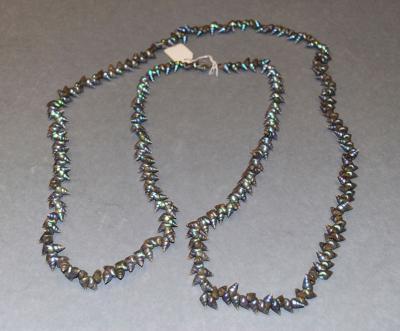Rare shell necklace to be returned to its homeland
Published: 18 March 2025
The Tasmanian Aboriginal Centre and The Hunterian at the University of Glasgow have announced the repatriation of a rare shell necklace from The Hunterian collection in Glasgow to its home in Tasmania.
The Tasmanian Aboriginal Centre and The Hunterian at the University of Glasgow have announced the repatriation of a rare shell necklace from The Hunterian collection in Glasgow to its home in Tasmania.
The Tasmanian Aboriginal shell necklace will be returned to Tasmania and transferred into the care of the Tasmanian Aboriginal Centre, where it will be accessible to the Tasmanian Aboriginal community for research, learning and inspiration.
The Tasmanian Aboriginal Centre has campaigned on behalf of the Tasmanian Aboriginal people for over four decades for the return of cultural property and ancestral remains from institutions around the world.
Tasmanian Aboriginal delegates have travelled to Glasgow to receive the necklace and take it home.
The unique shell necklace is believed to originate from the Bass Strait islands, located between Tasmania and mainland Australia. It is recorded as being donated to The Hunterian by Mrs Margaret Miller of Launceston on a visit to Scotland in 1877.
 Measuring 148cm, the necklace features elenchus or maireener shells, Phasianotrochus irisodontes, found off the coast of Tasmania. It is attributed to the women makers of the Bass Strait islands, although the individual maker’s name is not recorded.
Measuring 148cm, the necklace features elenchus or maireener shells, Phasianotrochus irisodontes, found off the coast of Tasmania. It is attributed to the women makers of the Bass Strait islands, although the individual maker’s name is not recorded.
Necklace making is the oldest continual cultural practice in Tasmania which has continued uninterrupted for thousands of years. Early shell necklaces are rare and considered a learning resource for present-day makers and significant heritage belongings with links to the past.
Early examples were shorter in length and worn as a single string around the neck. Later examples are longer with strings worn looped around the neck.
The sourcing, collecting and stringing of shells is a closely guarded tradition, passed down through generations of women makers associated with the Bass Strait islands. The intricate and painstaking practice is now acknowledged as a highly skilled and unique Aboriginal art form. Today there are concerns that the practice may die out due to a decline in the number of shells, attributed to climate change.
Shell necklaces were attractive to 19th-century collectors as cultural and aesthetic ‘first contact’ items, purchased and donated on the false premise that they were the possessions of the last descendants of an extinct people.
Produced for personal adornment and barter or trade, post-colonisation the necklaces became a commodity exchanged for essential supplies. During the 19th century, the sale of necklaces developed as one of the few commercial enterprises available to Aboriginal people on the Bass Strait islands.
Examples reached European museums by the mid-19th century and at least 16 examples are still held in UK collections including the British Museum, the Victoria and Albert Museum and National Museum of Scotland. It was during this period that the necklace in the collection of The Hunterian was made, sold or traded.
Each shell necklace is unique, with the patterns and shell types indicating the maker and place of creation. The necklace in The Hunterian is attributed by its original purchaser to the Bass Strait islands but the maker is not recorded. Examination of the shells, stringing method and pattern may enable identification of the maker and reconnect the necklace with its community of origin.
Previous returns of cultural property have included a traditional shell necklace and similar bracelet from Exeter Museum, England in 1997. These and other cultural items are now displayed at the Tasmanian Aboriginal Centre main facility. A number of shell necklaces are held in the collections of the National Museum of Australia.
A first request to return the necklace was made by the Tasmanian Aboriginal Centre in 1995 but was refused by University’s Museums and Galleries Committee. A second request made in 2002, following a visit from Tasmanian Aboriginal delegates, was also rejected on the grounds that “there was no evidence that the acquisition of the Bass Straits necklace was unethical in any way.”
Attitudes to repatriation have changed dramatically since then and as part of its aim to be an ethical institution, The Hunterian welcomes repatriation claims and prioritises the return of non-British culturally significant heritage items.
Jeanette James, an Elder and shell necklace stringer in her community said:
“The physical presence of original objects is critical in projects aimed at recovering traditional knowledge to continue practices and rebuild and extend traditional skills.”
Andry Sculthorpe, delegate and project manager at the Tasmanian Aboriginal Centre said:
"The Hunterian has graciously and with goodwill accepted our claim to our important cultural items. The situation for Tasmanian Aboriginal people since invasion has meant that every cultural piece made by our ancestors is precious and rare and maintains our connection with our culture and identity."
Professor Steph Scholten, Director of The Hunterian said:
“I am glad that we can set a new precedent today: that the University of Glasgow and The Hunterian, amongst a growing number of museums, are open to discussing and acting on repatriation claims. We have come to understand the urgent need for museums in Europe and beyond to address their pasts in equitable ways with originating and diasporic communities.”
First published: 18 March 2025
<< News

